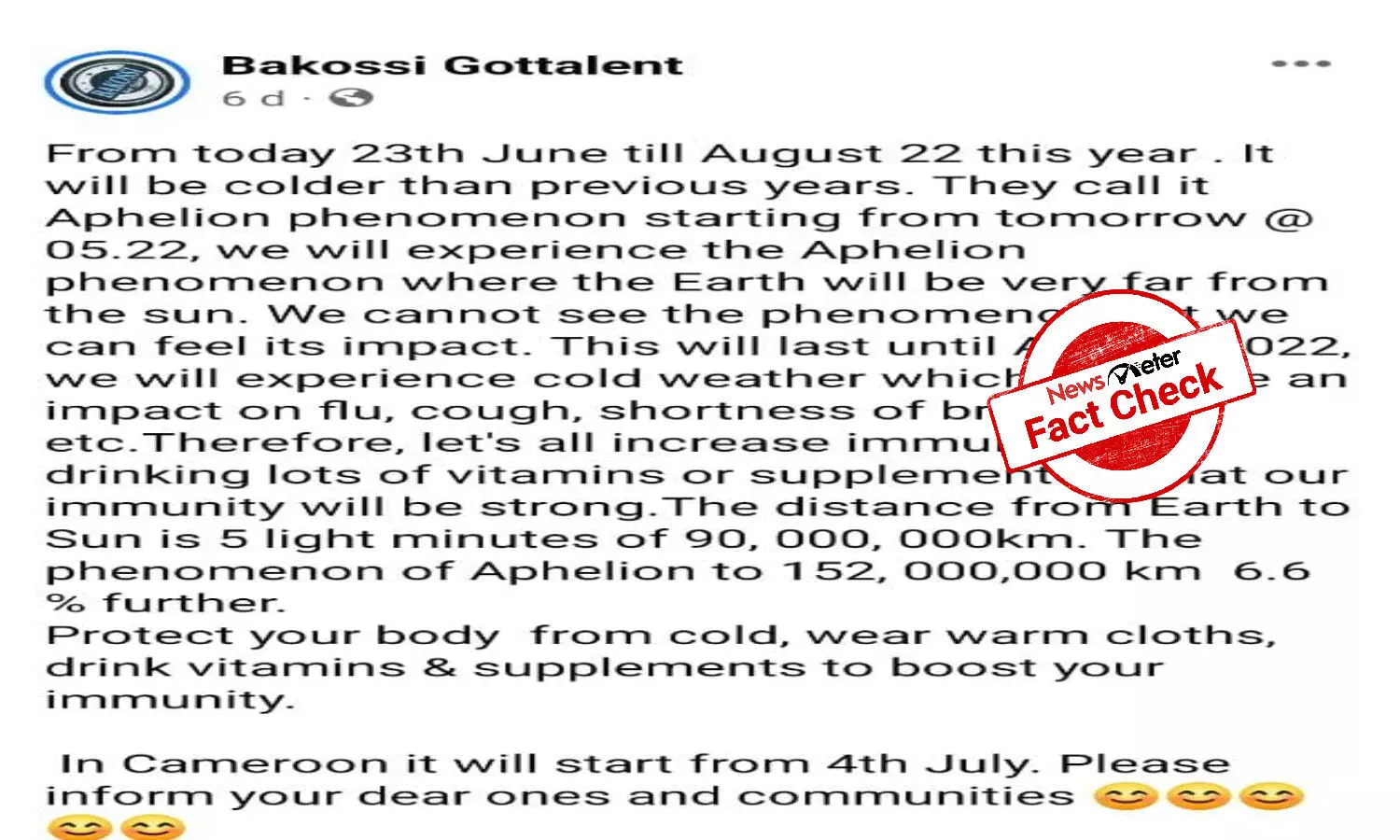No 'aphelion phenomenon' approaching: Don't heed rumors
A post warning users of the 'aphelion phenomenon,' is being circulated on social media. Users claim that a drop in global temperature to below normal levels that will last until the end of August.
By Newsmeter Network
Hyderabad: A post warning users of the 'aphelion phenomenon,' is being circulated on social media. Users claim that a drop in global temperature to below normal levels that will last until the end of August.
Click here to view.
JUST IN📍📍
— The KNUST TigerEye Media Inc. (@knusttigereye) June 11, 2022
From tomorrow 12th June till August 22nd ,it will be colder than previous years .We call it 'Alphelion phenomenon ',which will have an impact on flu,cough and shortness of breath . Let's take in more vitamins ~Knust Lecturer#Knust#KNUSTTigerEye👁️ pic.twitter.com/AVB15t2MJn
I hope it's true. Today weather is….. pic.twitter.com/XGgO54ZVrv
— MAK Mringo (@SnrDirector) June 1, 2022
Fact Check
The claim is false.
NewsMeter conducted a keyword search with the words - aphelion phenomenon- and found an article by Africa Check uploaded on April 26, 2022, titled Are you affected by 'aphelion phenomenon'?
We found the word aphelion in Britannica, according to that, the aphelion of an object is the point in its orbit around the sun when it is the farthest away from the sun. This is because these orbits are not perfectly circular.
As a result, the Earth is sometimes closer to the sun and sometimes further away. The closest point to the Sun is referred to as the Earth's perihelion.
https://www.britannica.com/
Both perihelion and aphelion occur once a year, and Earth's aphelion in 2022 is not unusual. As a result, as winter approaches, the southern hemisphere will not experience "cold weather worse than the previous cold weather."
Searching further, according to the US Navy, perihelion will occur on January 4, 2022, and aphelion will occur on July 4, 2022.
According to Steven C. Rockport's report by the University of Southern Maine, Aphelion does affect our weather, but not in the way you might think.
To begin, we should explain that the Earth's orbit is not perfectly circular. If it were, the Earth's distance from the Sun would remain constant. However, because it is a slightly elongated ellipse, its distance varies throughout the year.
Its distance varies between its minimum (perihelion) in early January and its maximum (aphelion) in early July. It is reasonable to assume that the Earth is hotter at perihelion than at aphelion. However, the difference in the amount of energy we receive from the Sun (known as the solar constant) does not vary significantly between perihelion and aphelion. The distance between perihelion and aphelion is only about three million miles,* a small fraction of Earth's average heliocentric distance of 93 million miles.
Because the northern hemisphere has more large land masses and less water, it experiences both warmer summers and colder winters. These are the factors that influence weather patterns, not the distance of the Earth from the sun.
Also, according to the viral post, the distance from Earth to the Sun is 5 light minutes or 90,000,000 km. But as per US National Aeronautics and Space Administration, the Earth is roughly 150 million kilometers from the sun.
https://solarsystem.nasa.gov/
Hence, the claim is false.